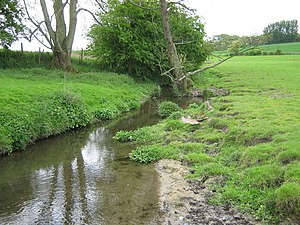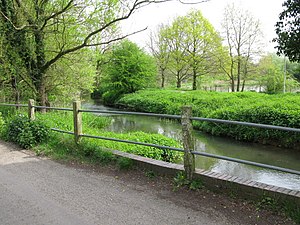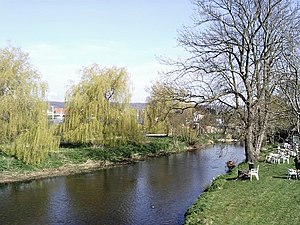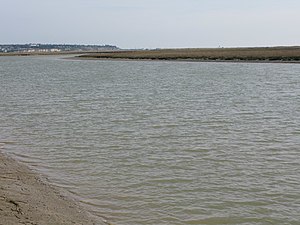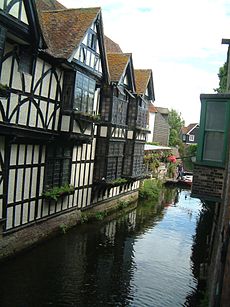River Stour, Kent
The River Stour is a river in Kent which flows into the English Channel at Pegwell Bay. Above Plucks Gutter, where the Little Stour joins it, the river is normally known as the Great Stour.
The upper section of the river, above its meeting with the East Stour at Ashford is sometimes known as the Upper Great Stour or West Stour. In the tidal lower reaches, the artificial Stonar Cut short cuts a large loop in the natural river.
The Stour has Kent's largest catchment area after that of the River Medway. The lower part of the river is tidal. Its original mouth was on the Wantsum Channel, an important sea route in mediæval times. The river has three major tributaries, and many minor ones. For much of its length it and flows in a generally south-west to north-east direction.
The city of Canterbury is situated on the river, as are the Cinque Port of Sandwich and the railway town of Ashford. The route of the Stour Valley Walk follows the river.
Contents
Course
Upper Great Stour
The source, of what is known at that point as the Great Stour, is near the village of Lenham, within a short distance of the River Len, a tributary of the Medway. That source is on the Greensand ridge and at first the river flows along the Low Weald valley at the foot of the ridge in a southeastward direction: three small streams enter from the north, having their headwaters on the ridge, before reaching a point where the river turns to the north east. This part of the river flows through rural countryside, passing the village of Little Chart, before entering Ashford near Great Chart.
The confluence with the East Stour, flowing from its source near Hythe, is to be found at Pledge’s Mill at the bottom of East Hill in Ashford.
Lower Great Stour
The town of Ashford marks the start of the middle section of the river, sited at a crossing point of the river and on ancient track ways. In Ashford the river helps form part of the Ashford Green Corridor.
After Ashford, the Stour breaches the North Downs; for most of this distance there are no tributaries. After the Brook stream enters from the right there are now 15 miles to Canterbury. In this stretch the river flows through the villages of Wye, Chilham and Chartham, with Wye being a fordable crossing.
The historic city of Canterbury lies at a junction of four Roman roads. Within the city the river flows in two channels, one through the centre of the city, and the other to the north of the city wills. The two channels rejoin to the east of Canterbury, before the river reaches Fordwich, a former outport of Canterbury and the current tidal limit of the river.
Beyond Fordwich, the river passes between several former gravel pits and through the reed beds of the Stodmarsh National Nature Reserve. Beyond the nature reserve lies the open farmland on the reclaimed marshes surrounding the river crossing at Grove Ferry Picnic Area, near the hamlet of Upstreet.[1]
At the hamlet of Plucks Gutter, the second of the large tributaries enters the main river: the 19-mile-long Little Stour, which begins life as the spring-fed Nailbourne stream. From here on the river is normally known as the River Stour.
River Stour
The twin villages in the parish of Stourmouth (West and East) mark the original point where the Stour entered the erstwhile Wantsum Channel, a strait used for hundreds of years until silting and land reclamation turned the sea channel into a large drainage ditch. At this point the third large tributary, the 8.4 mile Sarre Penn (named locally as the ‘’Fishbourne Stream’’) enters with the Wantsum Channel.
Here the river turns southwards to the once-thriving port of Sandwich, after which it loops back on itself to the north before entering the Strait of Dover at Pegwell Bay. The Stonar Cut obviates the need for seagoing craft to take the longer route around the loop at Sandwich.[2]
From the tidal limit at Fordwich to the sea the river is fringed with marshes. Most of them are located on what was the floor of the Wantsum Channel, whilst those to the south lie behind the sand dunes of the Sandwich Flats. These marshes are criss-crossed with drainage ditches. The principal marshes are those of Chislet, within the ancient estuary of the river; Wade, west of Birchington; and Ash Level.
Stonar Cut
In the mid-18th century it became necessary to alleviate the problem of flooding along the lower course of the Stour. The action of tidal drift of shingle along the coast had resulted in the huge loop at the estuary end of the river, and on 29 November 1774 an Act of Parliament was passed to bypass the loop at it narrowest end, at Stonar. The works, to become known as the Stonar Cut, made use of an existing sluice to cut across the neck of the loop, and were completed in 1776.
During World War I huge volumes of both troops and supplies were needed on the Continent and, in the utmost secrecy, a new port was built at Richborough. Landing facilities along the Cut were built, and the East Kent Light Railway was extended to service the port. Nothing now remains of much of those works, and the Cut has been allowed to return to its natural state.[3]
Major tributaries
East Stour
The East Stour is 10.3 miles long. It rises on the Greensand ridge at Postling north of Hythe as a number of small streams. It then flows under the M20 motorway to continue in a westward direction: the river meanders across the Low Weald plain, passing Mersham on the way. The East Stour's confluence with the Great Stour is on both sides of Pledge’s Mill at the foot of East Hill, Ashford.
The South Willesborough Dykes are on the banks of the East Stour in Willesborough, Ashford and helps form part of the Ashford Green Corridor.
Little Stour
The Little Stour is 9 miles long. Its upper reaches are better known as the Nailbourne, whilst the lower reaches were once known as the Seaton Navigation.
The intermittent source of the river is at Lyminge, and in its early reaches from Lyminge to Littlebourne it forms a chalk stream and winterbourne that is normally known as the Nailbourne. Below Littlebourne the river is better known as the Little Stour, and it joins with the Great Stour at Plucks Gutter near West Stourmouth.
River Wantsum
- Main article: River Wantsum
The River Wantsum is 6.7 miles long. It rises at Reculver and falls into the Stour at Stourmouth.
History
In Roman and mediæval times the river was an important highway, connecting Canterbury with Europe. Fordwich became important to shipping after the silting up of the southern entrance to the English Channel.
In 1831 Joseph Priestley wrote his ‘’Historical Account of the Navigable Rivers, Canals and Railways’’.[4] In it he described in one section the ‘’Canterbury Navigation, or River Stour’’. He includes an account of its course and the improvements being carried out at that time to assist navigation, and details of new port facilities.
Man has used the River Stour and its tributaries for centuries as a source of power. Many different processes were performed by the use of water power:- Corn milling, fulling, paper making and electricity generation. Many of the mills survive today as house conversions, with two of them still working commercially.
Fishing
The Great Stour estuary at Plucks Gutter and Grove Ferry is renowned for its coarse fishing, particularly bream stocks.[5]
Flooding
The lower-lying parts of Canterbury have in the past been particularly prone to flooding . The River Stour (Kent) Internal Drainage Board has the responsibility of reducing that risk in the river catchment area [6][7]
References
- ↑ "Stour Valley Walk". Kent County Council. http://www.kent.gov.uk/leisure_and_culture/countryside_and_coast/walking/stour_valley_walk.aspx. Retrieved 2010-03-15.
- ↑ http://www.wantsumangling.co.uk/stour.htm
- ↑ "Introduction". Stonar Cut. UK: Trust for Thanet Archaeology. http://www.thanetarch.co.uk/Virtual%20Museum/2_Galleries/G11%20Content/Virtual_Museum_Gallery_11_Display_1.html. Retrieved 2010-03-15.
- ↑ Joseph, Priestley (1831). Canterbury Navigation, or River Stour, Joseph Priestley 1831 Historical Account of the Navigable Rivers, Canals and Railways of Great Britain. London: Longman, Rees, Orme, Brown and Green. pp. 131–137. http://books.google.com/books?id=eUqIucVmZjwC&pg=PA131&lpg=PA131&dq=river+stour+priestley+1831 Canterbury Navigation, or River Stour, Joseph Priestley 1831. Retrieved 2010-03-15.
- ↑ "Angling Opportunities - Kent". Environment Agency. Archived from the original on 2007-09-30. http://web.archive.org/web/20070930153752/http://www.environment-agency.gov.uk/commondata/acrobat/fishing_kent.pdfsm. Retrieved 2010-03-15.
- ↑ "River flooding". Nature Grid. http://www.naturegrid.org.uk/rivers/gt%20stour%20case%20study-pages/fld-rvr.html. Retrieved 2010-03-15.
- ↑ "River Stour (Kent) Internal Drainage Board". River Stour (Kent) Internal Drainage Board. http://www.riverstouridb.org.uk/. Retrieved 2010-03-15.

